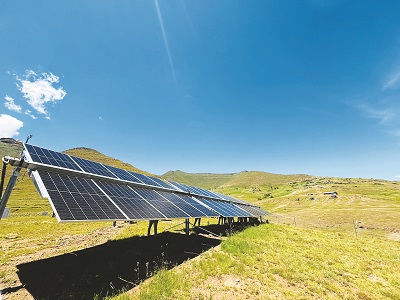By: Thoboloko Ntšonyane
MOKHOTLONG – Remote and far villages from the national electricity are set to be powered through solar mini-grids, under the “Sotho Minigrid Project” implemented by OnePower, and co-financed with the support of (EU) funded Electrification Financing Initiative (EDFIElectriFI) the (UK) -funded Renewable Energy Performance Platform Platform (REPP), UNDP, GEF and USAID.
One of the ongoing project is at Mokhotlong the beneficiaries Tlhanyaku and Matsoaing.
Following the successful implementation of the Sotho Minigrid Project, the European Union (EU) said it is in mission to boost the Lesotho clean energy sector, recently launched the Reneweable Lesotho programme.
The Renewable Lesotho is a joint effort between the government of Lesotho (GoL) and its development partners including the European Investment Bank (EIB), European multi-donor platforms GET.transform and GET. invest, the Association of Bilateral European Development Finance Institutions (EDFI), the German Federal Ministry of Economic Cooperation and Development (BMZ), Deutsche Gesellschaft für Internationale Zusammenarbeit (GIZ) and the United Nations Development Programme (UNDP).
The EU commits M300 million to this project and the German government M17.5 million.
Renewable Lesotho responds to Sustainable Development Goal (SDGs) no. 7 which calls for clean energy. It is also aligned to the National Strategic Development Plan II (NSDP II) and it is covered in the EU-Lesotho cooperation strategy 2021-2027 and the Team Europe Initiative-Green Deal.
The European Union (EU) Head of Delegation in Lesotho Paola Amadei says EU is concerned about access to energy for Basotho hence EU’s support towards clean energy.
She highlights that “Without additional investment in renewable energy Lesotho will not be able to provide electricity to all its citizens by 2030,
“The other aspect is climate change. Indeed the impact of Lesotho to climate change is a limited one, as a country which is strongly affected by climate change it has to invest in sources of energy that will not have a carbon footprint that will continue to deteriorate the situation ”..
The Renewable Lesotho project will create jobs for Basotho as it is rolled-out in the country.
Solar mini-grids are handy for communities which are very far from the national grid.
“These mini-grids serve different communities around [the country]. The investment in mini-grids brings benefits to Basotho without adding any burden to the government,” she says.
The Ambassador states that the subsidy issue in the beneficiary communities is still under discussion to ensure equity and to provide relief for users facing higher prices, especially the unemployed.
The Ministry of Energy’s public relations officer (PRO) Molisenyane Tau says this project is expected to reach 25 villages in Mokhotlong.
While installation is ongoing, Tau says 115 households have been connected to the mini-grids. These include a church, school and local commercial space.
The beneficiaries form schemes and commit a M500 fee for the functional benefits of the grid..
The first independent power producer in Lesotho after LEC, OnePower, a clean energy company, has been given a 25 year concession by the government to service Tlhanyaku, Matsoaing, Ha-Makebe, Lebakeng, Tosing, Sebapala, Sehlabathebe, Mashai, Sehonghong, Ribaneng and Ketane areas.
That is, that will be the only company that supplies, generates and sells to these communities for a period of 25 years.
While it is a private company, it has social objectives and is funded through equity.
The company’s project manager, Tumelo Makhetha says the Matsoaing and Tlhanyaku project’s completion will see 2 000 households’ connection. The total number of connections throughout the whole project will be approximately 14 000 new households.
Beneficiary areas were identified by the government.
Makhetha’s power is similar to that of the Lesotho Electricity Company (LEC) national utility and is assured that their customers hardly face power outages as they have the backup generators.
The only difference with that of LEC is that their generation is solely through the sun.
End users only pay for the connection as this is a subsidized project. Upon completion of connection to the grid, users may then buy energy in the form of units.
The EU Programme Manager Water, Energy and Climate Change Silvia Sala Giner says the committed investments are focused at penetrating the country whose rural power connection is reportedly below 40%.


